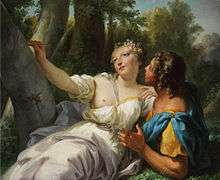Orlando furioso (Vivaldi)
| Orlando furioso | |
|---|---|
| Opera by Antonio Vivaldi | |
 18th-century depiction of Angelica and Medoro whose marriage in act 2 drives Orlando into a rage | |
| Librettist | Grazio Braccioli |
| Premiere |
November 1727 Teatro Sant'Angelo, Venice |
Orlando (RV 728), usually known in modern times as Orlando furioso (Italian pronunciation: [orˈlando fuˈrjoːzo]), is an opera in three acts by Antonio Vivaldi to an Italian libretto by Grazio Braccioli, based on Ludovico Ariosto's epic poem Orlando Furioso (The Frenzy of Orlando). The first performance of the opera was at the Teatro San Angelo, Venice, in November 1727. It is to be distinguished from an earlier Vivaldi opera of 1714, Orlando furioso, set to much the same libretto, once thought to be a revival of a 1713 opera by Giovanni Alberto Ristori but now considered by Vivaldian musicologists to be a fully-fledged opera by Vivaldi himself.[1]
The opera – more formally, the dramma per musica – alternates arias with recitative, and is set on an island at an unspecified time. The story line combines several plot lines from Ariosto: the exploits of the hero Orlando are detailed, as well as the tale of the sorceress Alcina.
Roles
| Role | Voice type[2] | Premiere cast November 1727 |
|---|---|---|
| Orlando, a knight jealous of Medoro | contralto | Lucia Lancetti |
| Angelica, beloved of Medoro | soprano | Benedetta Serosina |
| Alcina, enchantress | contralto | Anna Girò |
| Bradamante, female warrior, beloved of Ruggiero | contralto | Maria Caterina Negri |
| Medoro, Prince betrothed to Angelica | contralto castrato | Casimiro Pignotti |
| Ruggiero, a knight following Orlando | contralto castrato | Giovanni Andrea Tassi |
| Astolfo | bass | Gaetano Pinetti |
Synopsis
Act 1
In a delightful garden in which two springs are seen, Medoro escapes from a shipwreck into the arms of his beloved Angelica. Alcina magically helps Medoro and he recounts how he was first captured, then shipwrecked. Orlando is jealous of Medoro, but Angelica lies and says Medoro is her brother.
Alcina is attracted to the knight Ruggiero. She uses her magic to make him forget Bradamante and love her instead. Bradamante discovers Ruggiero's "betrayal." She shows him the ring he gave her therefore breaking Alcina's spell. Ruggiero feels guilty for his actions.
Act 2
In a grove with green secluded spots, Astolfo reflects how he loves Alcina, but is tormented by her unfaithfulness.
Meanwhile, in a mountainous alpine region with a high, precipitous cliff, Angelica and Medoro swear their love and part ways. To rid herself of Orlando, Angelica sends him to fight a monster who guards an elixir of youth.
Orlando enters a cavern and is trapped. Realizing Angelica's faithlessness, he digs his way out.
Angelica and Medoro marry in a countryside at the foot of a hill. They carve their vows on a nearby tree. Orlando finds the tree, and on reading the inscription, becomes so furious that he starts destroying the trees.
Act 3
The place is at the Entrance Hall before the Temple of Hecate. Astolfo believes Orlando dead. With Ruggiero and Bradamante, he plots revenge against Alcina. The secret of Alcina's power lies in an urn, which is locked in the temple of Hecate. They await Alcina's return.
Inside the temple of Hecate, Bradamante disguises herself as a man. Alcina falls in love with her. Orlando, still raving mad about the marriage of Angelica and Medoro, fights with the temple statues, inadvertently destroying Alcina's power.
In a deserted island. Alcina tries to attack the sleeping Orlando, but is prevented by Ruggiero and Bradamante. Astolfo returns to arrest Alcina. Orlando regains his reason and forgives Angelica and Medoro.
Recordings
- 1978: Marilyn Horne, Victoria de los Ángeles, Lucia Valentini Terrani, Carmen Gonzales, Sesto Bruscantini, Nicola Zaccaria; I Solisti Veneti, Claudio Scimone; Erato
- 1990 (video recording): Marilyn Horne, Susan Patterson, Kathleen Kuhlmann, Sandra Walker, William Matteuzzi, Jeffrey Gall, Kevin Langan; Orchestra and Chorus of the San Francisco Opera, Randall Behr, production by Pier Luigi Pizzi; Pioneer Artists/ArtHaus/Vision Video
- 2004: Marie-Nicole Lemieux, Jennifer Larmore, Veronica Cangemi, Ann Hallenberg, Philippe Jaroussky, Blandine Staskiewicz, Romina Basso, Lorenzo Regazzo; Ensemble Matheus; Jean-Christophe Spinosi; Naïve OP30393
- 2008: Anne Desler, Nicki Kennedy, Marianna De Liso, Luca Dordolo; Coro da Camera Italiano; Modo Antiquo, Federico Maria Sardelli. CPO
References
Notes
- ↑ Reinhard Strohm, The operas of Antonio Vivaldi, Florence, Olschki, 2008, I, p. 122, ISBN 978-88-222-5682-9. Vivaldi's personal responsibility for the 1714 opera had been established in 1973 by Strohm himself in his Zu Vivaldi's Opernschaffen, later published in Maria Teresa Muraro (ed.), Venezia e il melodramma nel Settecento, Florence Olshki, 1978, pp. 237–248. Federico Maria Sardelli has accordingly assigned the new catalogue number RV 819 to the 1714 opera.
- ↑ Eric Cross. "Orlando furioso". In L. Root, Deane. Grove Music Online. Oxford Music Online. Oxford University Press. (subscription required)
Sources
- Casaglia, Gherardo (2005).[http://www.amadeusonline.net/almanacco?r=&alm_giorno=10&alm_mese=11&alm_anno=1727&alm_testo=Orlando_furioso "Orlando furioso, 10 November 1727"]. Almanacco Amadeus (Italian).